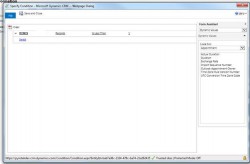In Microsoft Dynamics CRM 2013, the Business Process Flow is a great way to keep track of where you are in your sales (or any other type of) process. There are also other methods, left over from previous versions of CRM, such as the Close Probability field and Sales Stage field. It can be tempting […]
Tip #44: Reflecting current user in CRM SSRS reports
It is a best practice to reflect the user running the report in an SSRS report and when the report was run in the report footer. This gives you a snapshot of who ran the report, and if there are any questions about the validity of the data reflected in the report, can be very helpful […]
Tip #43: Embed a pre-filtered report in an iFrame
One of the benefits of the Microsoft Dynamics CRM SSRS pre-filtering capabilities is that you can run a report in context of a record, such as an account, so when you run the report, it just shows data related to that record. Reports can also be embedded in forms with iFrames, and prefiltering is very […]
Tip #37: Update user information in CRM Online (Office 365)
If you use CRM Online on the Office 365 platform, you will notice that the main fields on the user record are read only. This is because user information is managed in Office 365 and synchronizes to CRM. For example, say you have a CRM environment that already contains active users, and you want to […]
Tip #36: Get Update Rollup 1 for CRM 2013
If you were an early adopter of CRM 2013, you will be happy to hear that Update Rollup 1 is available for Microsoft Dynamics CRM 2013. Get the download here. Read the knowledge base article here, which details everything that is changed in Update Rollup 1.
Tip #33: Create a two-action ribbon button
Do your users have a CRM process that requires them to perform two unrelated actions in CRM? For example, a marketing department needs to run a mail merge and then have a workflow update the same selected records. Since these are separate actions, it can be cumbersome to the users, and can also have a […]
Tip #29: Solve missing permission issues

Sometimes, especially when you upgrade CRM or you add new entities, one of your users may see an error message like this: This error means that the user’s security role is missing a permission required for the object they are trying to view or the action they are trying to do. In this example, the […]
Tip #27: Conditional action in dialog based on record counts

One of the more powerful things that can be done with a dialog is querying data. You can query data in CRM to populate a picklist, and my favorite use of it is to query data and then base a conditional action on the record count. Consider this scenario: You sell to businesses, you have […]
Tip #25: Make bit fields required in Business Process Flows
In the new Business Process Flow functionality in CRM 2013, what if you want to have a bit field that must equal yes before the user can advance to the next process stage? When you add a new bit (two option) field with the default values and make it required, when the record is viewed, […]
Tip #23: Swap Customer Addresses

In Microsoft Dynamics CRM, the contact and account entity form display the first two addresses for the customer, and by default, addresses 3 and greater are displayed in the address link on the navigation bar (AKA more addresses). Consider this scenario: you are a wealth management company, and some of your clients are retired “snowbirds” […]
 of the
of the